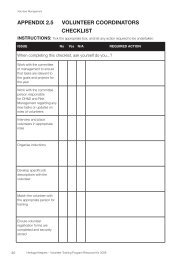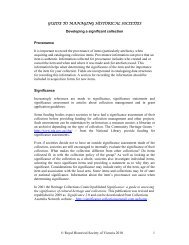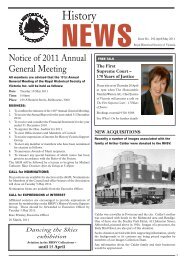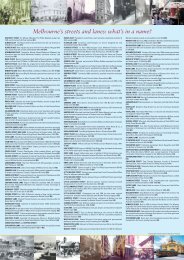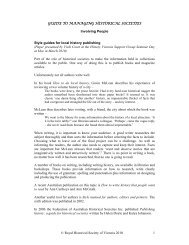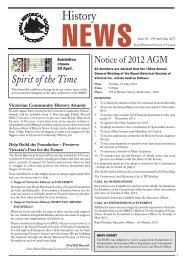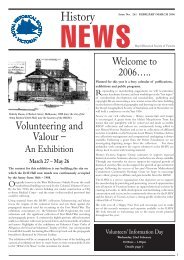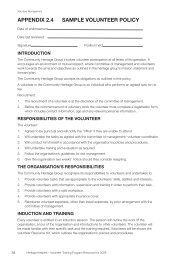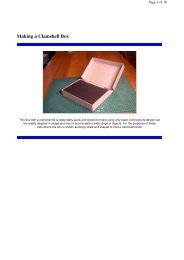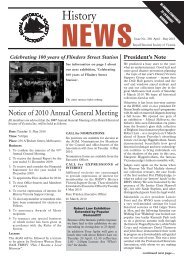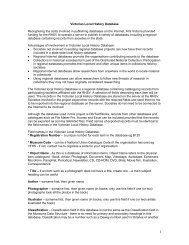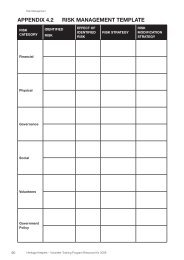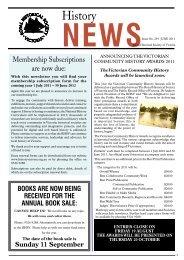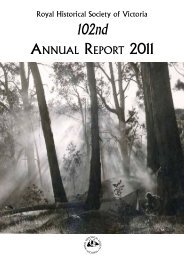RHSV History News June 2012 - Royal Historical Society of Victoria
RHSV History News June 2012 - Royal Historical Society of Victoria
RHSV History News June 2012 - Royal Historical Society of Victoria
You also want an ePaper? Increase the reach of your titles
YUMPU automatically turns print PDFs into web optimized ePapers that Google loves.
<strong>RHSV</strong> & COMMUNITY NEWS<br />
6<br />
Thank you and Good bye<br />
to MC2<br />
STAGED CLOSURE OF MC2<br />
The My Connected Community (mc²)<br />
social networking website was developed<br />
in 2001, as a platform for individuals and<br />
community groups to establish a web<br />
presence and start or join an online group<br />
based on shared interests.<br />
Eleven years later, there is now a wealth <strong>of</strong><br />
accessible social networking options that<br />
are easy to use and freely available. The mc²<br />
website will be closing on 30 <strong>June</strong> <strong>2012</strong>,<br />
this will be a staged closure and will include<br />
information and support where required.<br />
Online guides are available for download<br />
via the mc² site to assist you as you make<br />
the transition to other social networking<br />
sites. Information includes:<br />
• How to export, or save, your files from<br />
mc²<br />
• Social networking options<br />
• Frequently Asked Questions (FAQ)<br />
We encourage you to export or save your<br />
mc² files and make use <strong>of</strong> the time available<br />
to establish and settle into your new online<br />
social networking forum. If you experience<br />
difficulties please contact the mc² help desk<br />
on 03 8664 7001 or 1800 629 835. Thank<br />
you for your patience and understanding as<br />
we implement a staged closure <strong>of</strong> the site<br />
between March and <strong>June</strong>, in preparation<br />
for conclusion <strong>of</strong> the site on 30 <strong>June</strong> <strong>2012</strong>.<br />
The mc² team would like to thank you for<br />
your support over the last 11 years. It has<br />
been a privilege working together to explore<br />
the social networking space. We wish you<br />
all the very best as you move on to explore<br />
new online horizons!<br />
The <strong>RHSV</strong> will be launching new forums<br />
to stay in touch, exchange ideas and spread<br />
the word about local history.<br />
Stay tuned – all will be launched in our<br />
July newsletter<br />
For your Diary<br />
<strong>History</strong> <strong>Victoria</strong> Support Group<br />
Seminar<br />
4 August at the <strong>RHSV</strong><br />
Working with Family <strong>History</strong> Groups<br />
Building on relationships with<br />
genealogists and family history groups.<br />
Booking details and full programme in<br />
July edition <strong>of</strong> <strong>History</strong> <strong>News</strong><br />
<strong>Victoria</strong>n Collections<br />
Linda Barraclough reports on the <strong>Victoria</strong>n Collections – an online<br />
cataloguing database for small collections.<br />
It was <strong>of</strong>ficially launched at the recent<br />
Museums Australia (<strong>Victoria</strong>) inaugural<br />
conference at Ballarat at the end <strong>of</strong><br />
March, but it has been bubbling along in<br />
the background for a while. The program<br />
began in mid 2010, and had a trial version<br />
online for some time, but is now firmly<br />
established at http://victoriancollections.<br />
net.au/. It is based on Collectish s<strong>of</strong>tware,<br />
and is a joint initiative <strong>of</strong> Museums<br />
Australia (<strong>Victoria</strong>) and Museum <strong>Victoria</strong>.<br />
The website describes it as “a free, easyto-use<br />
online cataloguing system especially<br />
created for small collecting organisations”.<br />
As I write, it lists 176 organisations and<br />
4,600 items online. Of them 55, or just<br />
under a third, have 20 or more items online.<br />
Using the website, organisations can log<br />
on to enter details <strong>of</strong> their holdings, search<br />
their own holdings or those <strong>of</strong> others. The<br />
public can search without a login required,<br />
but are only able to see part <strong>of</strong> the record.<br />
Organisations can choose to make the<br />
record publicly available (although only<br />
certain, set parts), or keep it for their<br />
eyes only. Locations <strong>of</strong> items, and donor<br />
details, for example, are not shown on the<br />
public view. Despite this some decisions<br />
are hard to understand, with the maker<br />
(ie sometimes an author, photographer or<br />
artist) is not available to the public, making<br />
it difficult to search for works by particular<br />
“makers”, unless this has also been<br />
included in the description. It is particularly<br />
difficult for books and documents.<br />
The structure and fields are based on the<br />
4th Edition <strong>of</strong> the <strong>Victoria</strong>n Cataloguing<br />
Manual for Small Museums, which is<br />
available online. The manual and <strong>Victoria</strong>n<br />
Collections are primarily for objects, and<br />
it is difficult to see how large collections <strong>of</strong><br />
reference material can be managed on there<br />
when fields such as author and publisher<br />
have been combined. There are, however,<br />
other fields not in the Cataloguing Manual<br />
structure, such as a useful screen for<br />
recording copyright and permission details,<br />
that especially applies to photographs.<br />
When <strong>Victoria</strong>n Collections was first<br />
announced, it was envisaged that<br />
organisations with existing catalogues<br />
(usually in DB Textworks/Inmagic) would<br />
be able to upload to the database, but this<br />
is yet to happen. The average historical<br />
society where cataloguing has been taking<br />
place for a time, generally has a catalogue<br />
<strong>of</strong> between 2,000 and 10,000 items, so<br />
it would seem important to have this<br />
information publicly available. Current<br />
verbal advice is that the upload will be a<br />
“once-only”, and that then organisations<br />
will be expected to manage their collections<br />
through <strong>Victoria</strong>n Collections. This is<br />
raising more than a little concern in the<br />
committed community <strong>of</strong> InMagic users,<br />
and it is difficult to see how uploads will<br />
happen when the fields are quite different<br />
from earlier structures, and the manner<br />
in which those fields are used also varies.<br />
Organisations are, however, encouraged<br />
to join and upload at least twenty items,<br />
even though they are maintaining their own<br />
catalogues with InMagic, and this appears<br />
to be a good opportunity to be part <strong>of</strong> the<br />
online community. This can be achieved<br />
using members’ computers, without<br />
having an internet connection where the<br />
<strong>Society</strong>’s holdings are kept. Although this<br />
is double entry, it is worth the effort to have<br />
significant items listed, and useful training<br />
is available in conjunction with this.<br />
From a personal point <strong>of</strong> view, I will not be<br />
totally changing from InMagic to <strong>Victoria</strong>n<br />
Collections for a number <strong>of</strong> reasons. Firstly,<br />
I have too many items entered already,<br />
and would lose too much information in<br />
fields that are not included in <strong>Victoria</strong>n<br />
Collections. I catalogue according to<br />
the 2nd Edition <strong>of</strong> the Manual, and it<br />
seems to have escaped the notice <strong>of</strong> those<br />
responsible for the manual that people<br />
do not just upgrade from one edition to<br />
another. Instead, it being easy to add extra<br />
fields with InMagic, they are added as<br />
needed. I am not prepared to lose fields<br />
I use, such as classifications, references,<br />
and details <strong>of</strong> who is responsible for initial<br />
entries.<br />
InMagic also provides many more search,<br />
export and report options that are not<br />
available in <strong>Victoria</strong>n Collections, that I<br />
am using continually. Data can easily be<br />
sorted in a number <strong>of</strong> ways. There is an<br />
attached Thesaurus for keywords/subjects<br />
– the tagging system used on <strong>Victoria</strong>n<br />
Collections currently produces somewhat<br />
strange results – try searching for a subject<br />
<strong>of</strong> Gold.<br />
With InMagic I can easily print out<br />
entire records for single items, or quickly<br />
construct complex reports in response to<br />
enquiries. It does not seem possible to print<br />
an entire record in <strong>Victoria</strong>n Collections.<br />
Those societies using only the online<br />
<strong>Victoria</strong>n Collections will not be able<br />
to upload to the <strong>RHSV</strong> <strong>Victoria</strong>n Local<br />
<strong>History</strong> Database at http://collections.<br />
historyvictoria.com.au/rhsvdatabases/



